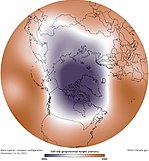
Back دوامة قطبية Arabic Vórtiz polar AST Полярен вихър Bulgarian पोलर वोर्टेक्स Bihari Vòrtex polar Catalan Polární vír Czech Polarwirbel German Vórtice polar Spanish Polaarpööris Estonian Bortize polar Basque
A circumpolar vortex, or simply polar vortex, is a large region of cold, rotating air; polar vortices encircle both of Earth's polar regions. Polar vortices also exist on other rotating, low-obliquity planetary bodies.[1] The term polar vortex can be used to describe two distinct phenomena; the stratospheric polar vortex, and the tropospheric polar vortex. The stratospheric and tropospheric polar vortices both rotate in the direction of the Earth's spin, but they are distinct phenomena that have different sizes, structures, seasonal cycles, and impacts on weather.
The stratospheric polar vortex is an area of high-speed, cyclonically rotating winds around 15 km to 50 km high, poleward of 50°, and is strongest in winter. It forms in Autumn when Arctic or Antarctic temperatures cool rapidly as the polar night begins. The increased temperature difference between the pole and the tropics causes strong winds, and the Coriolis effect causes the vortex to spin up. The stratospheric polar vortex breaks down in Spring as the polar night ends. A sudden stratospheric warming (SSW) is an event that occurs when the stratospheric vortex breaks down during winter, and can have significant impacts on surface weather.[citation needed]
The tropospheric polar vortex is often defined as the area poleward of the tropospheric jet stream. The equatorward edge is around 40° to 50°, and it extends from the surface up to around 10 km to 15 km. Its yearly cycle differs from the stratospheric vortex because the tropospheric vortex exists all year, but is similar to the stratospheric vortex since it is also strongest in winter when the polar regions are coldest.
The tropospheric polar vortex was first described as early as 1853.[2] The stratospheric vortex's SSWs were discovered in 1952 with radiosonde observations at altitudes higher than 20 km.[3] The tropospheric polar vortex was mentioned frequently in the news and weather media in the cold North American winter of 2013–2014, popularizing the term as an explanation of very cold temperatures. The tropospheric vortex increased in public visibility in 2021 as a result of extreme frigid temperatures in the central United States, with experts linking its effects to climate change.[4]
Ozone depletion occurs most heavily within the polar vortices – particularly over the Southern Hemisphere – reaching a maximum depletion in the spring.
- ^ Read, P.L. (August 2011). "Dynamics and circulation regimes of terrestrial planets". Planetary and Space Science. 59 (10): 900–914. Bibcode:2011P&SS...59..900R. doi:10.1016/j.pss.2010.04.024.
- ^ "Air Maps", Littell's Living Age No. 495, 12 November 1853, p. 430.
- ^ "GEOS-5 Analyses and Forecasts of the Major Stratospheric Sudden Warming of January 2013" (Press release). Goddard Space Flight Center. Retrieved January 8, 2014.
- ^ Plumer, Brad (16 February 2021). "A Glimpse of America's Future: Climate Change Means Trouble for Power Grids". The New York Times.
© MMXXIII Rich X Search. We shall prevail. All rights reserved. Rich X Search

